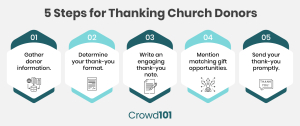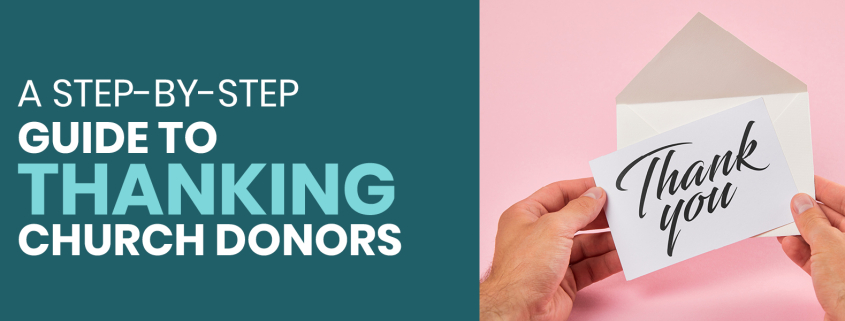A Step-by-Step Guide to Thanking Church Donors
Imagine this: you’ve just pulled off a successful church fundraiser. Your team raised a record-breaking amount of funds, and you’re ready to jump into planning your next fundraising campaign, equipped with the knowledge you’ve gained from your newfound success.
However, you’re missing a vital step of the fundraising process before you can close out the campaign for good: expressing gratitude. In this guide, we’ll walk you through how to thank your church donors step by step so you don’t miss a thing and ensure your church community receives adequate appreciation. Let’s get started!

1. Gather donor information.
It’s important to make your thank-yous specific so you acknowledge individual contributors. Consult your donor database to find information that can enhance your note, such as:
- Full names
- Gift amounts
- Engagement history
For example, if your church recently fundraised for a large project such as a new building or launched a new missions program, it’s essential to thank the generous community that helped you accomplish that goal. Averill Solutions describes this as part of the “follow-up” phase which includes expressing gratitude to strengthen existing relationships within your congregation
From there, you can use the information you’ve collected to personalize your gratitude. For instance, you might send a message that says “Dear Cathy, thank you for your generous contribution of $700 to support our new children’s ministry! We appreciate your continued support.”
2. Determine your thank-you format.
There are a variety of different ways you can communicate your appreciation to donors. Methods you may consider using include:
- eCards. To engage your donors in an exciting new way, use interactive eCards to show your appreciation.
- Emails. A standard thank-you email is an easy way to reach donors and show them that you care.
- Texts. Quickly and efficiently thank your donors by sending a thank-you text message.
- Videos. Thank-you videos can take your appreciation efforts to the next level and demonstrate that you’re willing to go the extra mile to thank your donors for their support.
Try using different gratitude formats depending on the initiative donors contributed to. For instance, those who supported general church funding could receive a personalized email. On the other hand, if your church just successfully launched a new women’s ministry retreat or college ministry, you can send a video of the staff thanking your church community.
3. Write an engaging thank-you note.
Now that you have your donor information and thank-you format ready to go, it’s time to write your thank-you note. eCardWidget’s donor thank-you letter guide recommends adhering to the following best practices:
- Emphasize your supporter’s generosity. Your thank-you notes should focus on your donors and their impact. Try to use second-person pronouns such as “you” and “yours” rather than first-person pronouns such as “we” and “us.” For example, it’s more powerful to say “Your generosity allows the congregation to prosper” rather than “We raised a significant amount of money for our church.”
- Be concise. Keep it short and sweet. You should write enough so that donors understand that you appreciate their support but not too much so as to waste their time. Aim for a few paragraphs.
- Offer additional engagement opportunities. Invite donors to get involved in your church in other ways. For example, they may be interested in volunteering to help run your services or attending an upcoming event.
Most importantly, put your appreciation for donors at the forefront of your thank-you note. Requesting additional donations will distract from donors’ generosity and make your appreciation efforts seem disingenuous.
Instead, remind them that they are a valuable part of your community and, especially if they’re new to your church, invite them to upcoming events or engagement opportunities to forge stronger relationships.
4. Mention matching gift opportunities.
If you’re not familiar with matching gifts, they’re donations employers make to causes their employees have contributed to. Typically, companies match employee donations at a 1:1 ratio, contributing the same amount that employees have to the same cause.
Even though matching gifts have the potential to double or even triple your donation revenue, 78% of donors are unaware if their employer offers matching gifts. Your donation thank-you letter is the perfect place to mention matching gift opportunities.
When you discuss matching gifts, make sure to:
- Demonstrate their impact. To convince donors to submit matching gift requests to their employers, show them how powerful these contributions can be. For instance, you may explain that the donor’s $50 contribution allows the church to provide meals for three families in the community in need whereas the donor’s contribution plus a $50 company match equates to meals for six families.
- Prompt donors to check their eligibility. Once you’ve shown donors how much matching gift funds can make a difference, ask them to check their eligibility. Their employers likely have set guidelines on their websites or in their handbooks that donors can reference before submitting their requests. For instance, many companies will only support religious organizations that provide social services such as food pantries or youth programs.
- Remind them there are no additional costs. The best part about matching gifts is they allow donors to double their impact without contributing any more of their own funds. Make sure it’s clear to donors that matching gifts don’t cost them anything beyond their initial contributions.
To encourage matching gifts even further, create a matching gifts page on your website. There, you may feature information about the matching gift process and embed a database that allows donors to verify their matching gift eligibility.
5. Send your thank-you promptly.
When you send your thank-you soon after a donor contributes to your campaign, it acts as a confirmation that you received their donation. Donors will see that you value your relationships with them and care that they feel appreciated immediately after contributing.
If possible, a good rule of thumb is to send your thank-you within 24-72 hours of receiving a donor’s gift. If you don’t have time to send an in-depth thank-you note right away, opt for a quick donation receipt or text to jumpstart the process.
Then, send an extended thank-you note, video, or email that details your appreciation for donors’ specific contributions to keep your cause top of mind.
Whether you’re trying to fill your annual fund, raise money for a mission trip, or develop a new building, your generous church community members are the ones who make it all happen. Be sure to thoroughly thank them so they know you appreciate their contributions. That way, you can build a consistent base of donors who uphold and support your church’s mission and activities.
